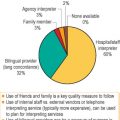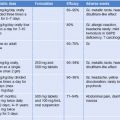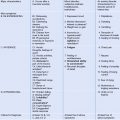CHAPTER 57 Healthcare for Migrant Workers
Introduction
The delivery of healthcare to migrant workers in the USA presents a unique challenge to those caring for the population. This chapter will address a number of those challenges and give examples of best practices that have been shown to improve outcomes for migrants. The populations we are addressing are largely from Central and South America and have migrated to the USA to work, in order to support local family members as well as those that have remained in their native countries. The migrant workers described in this chapter include migrant and seasonal farmworkers and day laborers. The vulnerability of this population stems in part from the nature of their work, their method of arrival into the country, and their documentation status.
Demographics and Trends
Migratory patterns
The nation’s immigrant population reached a new high of more than 35 million in 2005, accounting for 12.1% of the total population, the highest percentage in eight decades. If current trends continue, within a decade it will surpass the high of 14.7% reached in 1910.1 The data also indicate that the first half of this decade has been the highest 5-year period of immigration in American history.1
Disparities in health, health insurance, and income for immigrants present barriers to both immigrants and healthcare professionals to obtaining and providing healthcare services. One-third of immigrants lack health insurance – two-and-one-half times the rate for natives. Immigrants and their US-born children account for almost three-fourths of the increase in the uninsured population since 1989. Reflecting low levels of coverage, workers and their families use very little healthcare compared to other low-income people. Immigrants may make significant economic progress the longer they live in the United States, but even immigrants who have lived in the United States for 15 years still have dramatically higher rates of poverty, lack of health insurance, and welfare use than natives.1
Immigrants are not evenly represented across the United States, with only a few states having the majority of the foreign-born population. More specifically, there are nearly 10 million immigrants in California, accounting for 28% of the nation’s total immigrant population, followed by New York, Texas, Florida, and New Jersey. These five states account for 63% of the nation’s total foreign-born population, but only 35% of the native-born population. States with the largest increase in immigrants are California, Texas, Georgia, New Jersey, Maryland, North Carolina, Pennsylvania, Washington, Virginia, Arizona, Tennessee, Minnesota, Nevada, New Mexico, South Carolina, and Mississippi.1
Mexico–US migration and health
Mexican migration to the US has been part of the relationship between the two countries for more than a century. The US demand for workers and Mexico’s inability to absorb workers into the workforce due to its own economy converge to create a rapid increase in the migratory flow and in the Mexican population residing in the US. Increased border security and pressure suggest an increasing undocumented population with even higher risks and costs associated with border crossings and integration into society. Unfortunately, this situation contributes significantly to limiting access to medical services and to increasing the health risks of migrants.2
Most workers who enter the country end up in jobs that require manual labor. The National Population Council of Mexico reports that even though the rate of employment for Mexican migrants is higher than US-born whites (71% versus 67%), these migrants are employed in lower paid manual jobs such as agriculture, landscaping, construction, office cleaning, food preparation, maintenance and repair, and production jobs that tend to have lower wages and no health insurance.2
Description of the Population
The higher incidence of poverty among immigrants as a group has significantly increased the overall size of the population living in poverty. Immigrants account for about one in six persons living in poverty. The data by country indicate that there is enormous variation in poverty rates among immigrants from different countries. For example, the 26% poverty rate for Mexicans is more than five times that of persons from Canada or the Philippines.1 Perhaps the fastest growing segments of the new immigrant population in rural and suburban/urban areas are in two special populations. In rural communities, migrant and seasonal farm workers are immigrants and their families working in agriculture, migrating from Mexico and other Latin American countries to the US, and then state-to-state, at times staying in the area over a season (called ‘seasoning over’). Entering more or less in the same manner from the same places, but moving to more suburban and urban areas, are day laborers. For the practitioner treating these special populations of immigrants, understanding of health practices in the migrants’ home communities and barriers to healthcare they experience from living in the US, such as poverty, lack of health insurance coverage, and language and cultural differences, can help in guiding treatment planning, provider expectations of setting patient self-management goals, and follow-through and referral practices.
Migrant and seasonal farm workers
Almost all migrant and seasonal farm workers are foreign born, with only 6% reporting being born in the United States. The majority (70%) remain in the United States and do not return to their country of origin. Although concentrated in certain areas of the country, migrant and seasonal farm workers reside in all states. They travel frequently between states for their employment. As a group, migrant and seasonal farm workers face significant language barriers. Approximately 90% say they read and speak little or no English. They are predominantly male (88%), over half are married, and over 40% have children. Even though migrant and seasonal farm workers report working 5–6 days a week, they are extremely poor. In 2000, the median income for migrant and seasonal farm workers was US$6250, compared to US$42 000 for US workers overall.3 Migrant and seasonal farm workers and their families are overwhelmingly uninsured. In 2000, 85% of migrant and seasonal farm workers were uninsured, compared to 37% of low-income adults nationally. Further, nine in ten children in farm worker families were uninsured compared to less than a quarter (22%) of low-income children nationally.3
Day laborers
There is a national system of day labor in the United States, encompassing men and women looking for employment in open-air markets by the side of the road, at busy intersections, in front of home improvement stores and in other public spaces. A recent report from the Center for the Study of Urban Poverty at the University of California at Los Angeles, analyzing data from the National Day Labor Survey, provides a portrait of day labor in the United States based on a national survey of 2660 day laborers. The study found that on any given day approximately 117 600 workers are either looking for day-labor jobs or working as day laborers. Seventy-five percent of the day laborer workforce are undocumented migrants. The dimensions of the day labor market are fluid; on a daily basis new workers enter this market while others leave it. Similarly, hiring sites diminish in size or disappear, while new ones emerge. The largest concentration of day laborers is in the West (42%), followed by the East, Southwest, South, and Midwest. Day laborers search for work in different types of hiring sites. Seventy-nine percent of hiring sites are informal, as described above, and are located near residential neighborhoods. One in five day laborers search for work at day labor worker centers. Nearly half of all day laborers are employed by homeowners/renters and 43% by construction contractors. Their top five occupations include construction laborer, gardener and landscaper, painter, roofer, and drywall installer.4
The vast majority of day laborers (83%) rely on day labor work as their sole source of income, with 70% searching for work five or more days a week. Three-quarters of day laborers have worked in this market for less than 3 years, suggesting that many make the transition into jobs in other sectors of the economy. Day labor pays poorly, with the median hourly wage approximately US$10. Even so, employment is unstable and insecure, resulting in annual earnings less than US$15 000, usually below the federal poverty threshold. Many day laborers support themselves and families through this work, with a significant number of day laborers married (36%) or living with a partner (7%); almost two-thirds (63%) have children. Twenty-eight percent of the children of day laborers are US citizens. The need for day laborers to earn an income, in most cases, is made all the more urgent by the responsibility to support their families.4
Day laborers regularly suffer abuse related to their employment. Almost half of all day laborers experienced at least one instance of wage theft in the 2 months prior to being surveyed. In addition, 44% were denied food/water or breaks while on the job. Workplace injuries are common, with one in five day laborers having suffered a work-related injury, and more than half of those who were injured in the past year did not receive medical care. More than two-thirds of injured day laborers have lost time from work.4
Access to Health Care
Cultural, language, and legal barriers
Successful models must produce positive short-term outcomes while ultimately assimilating patients into a larger public healthcare system.5 A ‘culturally sensitive model’ often demands language assistance or translations. As a result, patients require linguistic flexibility (often in the form of Spanish–English bilingualism), either with a bilingual healthcare provider or translation available through the medical team. In addition, many cases require an understanding of the cultural norms and the economic and political environment from which immigrant populations come.6 This requires research and understanding of the identity of the individual being served. For example, reactions to conventional medical treatment may reflect the cultural taboos and practices of religious groups. An understanding of these beliefs and practices facilitates medical treatments in terms of scheduling appointments and phrasing explanations of treatments. On a more clinical level, certain pharmaceutical treatments may be less effective among certain Latin populations due to genetic and sociocultural factors.7 This can be seen in the arena of mental health, where it is often difficult for this population to address clinical depression through psychotherapeutic and pharmaceutical interventions. In addition, one recent study in pharmacogenetics and asthma demonstrated different responses to asthma medications in Latinos with certain genetic backgrounds.8
Although Mexican immigrants may travel home frequently, many individuals from more distant countries, such as Ecuador and Guatemala, have neither resources nor the will to repeat the long journey from their respective countries. ‘Andando por la pampa’ (walking the plains) means years of separation from family and home and expresses the sense of vast distance and isolation of the migrant who does not have the ability to travel back and forth on a yearly basis.9 This also takes a toll on medical outcomes. Because of these disparities of outlook and culture, providers must assist the Latin community one by one, as individuals, taking into consideration the uniqueness of each particular situation.
Lack of insurance
Table 57.1 reports the percentage of immigrants and natives who were uninsured for all of 2004. The table shows that lack of health insurance is a significant problem for immigrants from many different countries. Overall, 33.7% of the foreign-born population lack insurance compared to 13.3% of natives. Immigrants now account for 26% of the uninsured. The lower portion of the table reports the percentage and number of immigrants and the US-born children (under 18) of immigrant mothers who are uninsured. In 2005, 29.3% of immigrants and their minor children were uninsured. In total, the 13.6 million uninsured immigrants and their children account for 30% of the uninsured, nearly double their 15.9% of the overall population.1
Table 57.1 Immigrants without health insurance
| Country | Number uninsured (in thousands) | Percentage uninsured |
|---|---|---|
| Guatemala | 316 | 58.0 % |
| México | 5812 | 53.8 % |
| Honduras | 191 | 50.4 % |
| El Salvador | 507 | 45.2 % |
| Ecuador | 151 | 44.5 % |
| Haití | 243 | 42.6 % |
| Brazil | 139 | 39.2 % |
| Peru | 122 | 37.0 % |
| Colombia | 149 | 31.1 % |
| Dominican Republic | 212 | 30.5 % |
| Cuba | 243 | 25.6 % |
| Jamaica | 154 | 25.4 % |
| Poland | 126 | 24.2 % |
| Vietnam | 240 | 24.1 % |
| Korea | 149 | 22.1 % |
| China | 397 | 21.7 % |
| Iran | 56 | 16.9 % |
| India | 232 | 16.4 % |
| Russia | 89 | 14.3% |
| Philippines | 211 | 13.8 % |
| Italy | 42 | 10.7 % |
| Great Britain | 55 | 9.3 % |
| Japan | 32 | 9.1 % |
| Canada | 55 | 8.2 % |
| Germany | 25 | 4.8 % |
| All Immigrants | 11 858 | 33.7 % |
| All Natives | 33191 | 13.3 % |
| Children (under 18) of immigrant mothers1 | 2849 | 19.6 % |
| Children (under 18) of native mothers2 | 5420 | 9.1 % |
| Immigrants and their US-born children1 | 13629 | 29.3 % |
| Natives and their children2 | 32191 | 13.2 % |
| Immigrants and their US-born children uninsured or on Medicaid1 | 21639 | 46.7 % |
| Natives and their children uninsured or on Medicaid2 | 61639 | 25.2 % |
1 Includes all children of immigrant mothers under age 18, including those born in the US.
2 Including the children of native mothers under 18. The US-born children of immigrant mothers are not included.
Source: Center for Immigration Studies analysis of March 2005 Current Population Survey.
Because of the limited value of their labor in an economy that increasingly demands educated workers, many immigrants hold jobs that do not offer health insurance, and their low incomes make it very difficult for them to purchase insurance on their own. The 2005 Center for Immigration Studies reports that nearly 47% of immigrants and their children either have no insurance or have it provided to them through Medicaid.3
Health Issues of the Migrant
In 2000, only 20% of migrant and seasonal farm workers reported using any healthcare services in the preceding 2 years. Further, one study found that only 42% of women in farm worker families reported seeking early prenatal care compared to over three-quarters (76%) nationally. Data show a nearly one in four incidence of undesirable birth outcomes and elevated rates of low birth weights and preterm births among this population.10–12
Health concerns of agricultural workers
There is much research to substantiate the fact that workers in the agriculture industry are at high risk of death and injury.10–12 The National Institute for Occupational Safety and Health ranks agriculture among the most hazardous industries. Farm workers are at high risk for fatal and nonfatal injuries, work-related lung disease, noise-induced hearing loss, skin diseases, and certain cancers associated with chemical use and prolonged sun exposure.10–12
Production agriculture, a segment of the agriculture industry, is the sector which commonly represents farming. Production agriculture has been shown to have higher rates of fatalities than the agriculture industry as a whole.13,14 Studies have shown young workers in agriculture to incur more serious injuries and a greater proportion of injury than the general young worker population.15–18 Reasons for the higher rates have been suggested as being inexperienced in the job/work method, a more hazardous work environment, and risk-taking behavior due to a feeling of invincibility by young workers.19,20
Although agricultural crop and livestock production constitutes only 2% of the workforce, from 1994 to 1999 it represented 13% of all occupational deaths.21 It is among the most dangerous occupations in the nation.22 In 2001, for every 100 000 agricultural workers in the US there were 22.8 deaths for a total of 228 occupational deaths in agriculture. This compares to a rate of 4.3 deaths for every 100 000 workers in the total US workforce during this same period.23 Injuries are not limited to adults. Child labor laws differ from state to state and many children work in the fields, sometimes alone, other times accompanied by parents. In Agricultural Safety Information published by NIOSH in 2001, it was reported that an average of 103 children are killed annually working on farms (1990–1996).24 Every day, about 500 agricultural workers suffer lost-worktime injuries, and about 5% of these result in permanent impairment.24 In a study of 287 migrant workers, 25 had reported an injury in the previous 3 years. Of these, 17 considered medical attention necessary. Forty-one percent of the injured workers did not receive medical attention within 24 hours, and 24% received no attention at all.25 Another study found sprains and strains to be the most common occupational injury, constituting 43% of agricultural injuries. Fieldwork was the activity most commonly associated (39%) with injury.22
Musculoskeletal
Musculoskeletal injuries are inherent to agricultural labor. Harvesting requires heavy and repetitive lifting and quick wrist and hand movements, and the piece-rate wage system encourages a rapid work pace. Such ergonomic conditions lend themselves to back and muscle pain. ‘In 1996, 34% of lost-time injuries were sprains and strains and 24% were back injuries.’22
Stay updated, free articles. Join our Telegram channel

Full access? Get Clinical Tree







